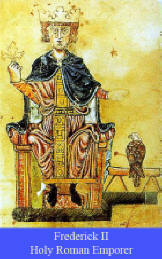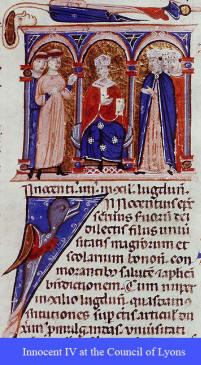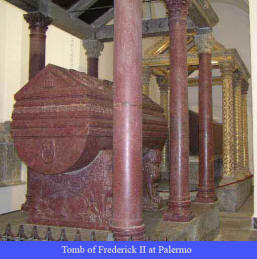The events that eventually brought the Crown of Aragon into direct
conflict with the Count of Anjou and the papacy originated with the long
struggle between various popes and the House of Hohenstaufen for control
of Italy and Sicily. While on the face of it, the events which occurred
after the death of Frederick II would seem to have little connection with
what was transpiring on the Iberian Peninsula, in fact, the very success
of the papacy and Charles of Anjou against the Hohenstaufens created a
situation which virtually assured that the two ascendant powers in the
Western Mediterranean would eventually collide. In order to understand the
involvement of the Crown of Aragon in Sicily the relationship of Charles
of Anjou and the papacy has to be examined.
that eventually brought the Crown of Aragon into direct
conflict with the Count of Anjou and the papacy originated with the long
struggle between various popes and the House of Hohenstaufen for control
of Italy and Sicily. While on the face of it, the events which occurred
after the death of Frederick II would seem to have little connection with
what was transpiring on the Iberian Peninsula, in fact, the very success
of the papacy and Charles of Anjou against the Hohenstaufens created a
situation which virtually assured that the two ascendant powers in the
Western Mediterranean would eventually collide. In order to understand the
involvement of the Crown of Aragon in Sicily the relationship of Charles
of Anjou and the papacy has to be examined.
When Frederick II (left), Holy Roman Emperor, died
in December of 1250, Pope Innocent IV had every reason to rejoice.
 Frederick had represented a real threat to the papacy ever since he became
emperor in 1220 over the objections of Pope Honorius III. The various
popes who had combated the Hohenstaufens had seen the holding of both the
Kingdom of Sicily,
together with Lombardy and Germany, as both a direct
threat and usurpation. With the Papal States hemmed in by the Emperor's
holdings and confronted with the resources the wealth of those lands could
purchase, the papacy feared that the Emperor was in a position to crush
the Holy See and return it to the state of submission to the Holy Roman
Emperors which had existed prior to the reform of the church in the
eleventh century. Moreover, the Kingdom of Sicily, or Regno, was seen as
being part of the Holy See due to the homage and fealty Pope Anacletus
received from Roger II for granting him the crown of the Kingdom of
Sicily, Calabria,
and Apulia in 1130. The Hohenstaufens had refused to
acknowledge that the Kingdom of Sicily was a vassal state of St. Peter,
and this, coupled with the immediate threat of encirclement, had resulted
in continual papal hostility. Thus, when Frederick II died in 1250, Pope
Innocent IV had reason to be pleased as it meant that one of the papacy's
most tenacious adversaries had been removed.
Frederick had represented a real threat to the papacy ever since he became
emperor in 1220 over the objections of Pope Honorius III. The various
popes who had combated the Hohenstaufens had seen the holding of both the
Kingdom of Sicily,
together with Lombardy and Germany, as both a direct
threat and usurpation. With the Papal States hemmed in by the Emperor's
holdings and confronted with the resources the wealth of those lands could
purchase, the papacy feared that the Emperor was in a position to crush
the Holy See and return it to the state of submission to the Holy Roman
Emperors which had existed prior to the reform of the church in the
eleventh century. Moreover, the Kingdom of Sicily, or Regno, was seen as
being part of the Holy See due to the homage and fealty Pope Anacletus
received from Roger II for granting him the crown of the Kingdom of
Sicily, Calabria,
and Apulia in 1130. The Hohenstaufens had refused to
acknowledge that the Kingdom of Sicily was a vassal state of St. Peter,
and this, coupled with the immediate threat of encirclement, had resulted
in continual papal hostility. Thus, when Frederick II died in 1250, Pope
Innocent IV had reason to be pleased as it meant that one of the papacy's
most tenacious adversaries had been removed.
 However, Frederick's death did not remove the threat to the
Holy See nor did it bring the Kingdom of
Sicily under papal control. If Innocent IV hoped to take advantage of the
situation, he was to be greatly disappointed. Conrad IV, Frederick's
eldest surviving legitimate son, moved swiftly, not only to gain the title
of emperor but also to enter northern Italy and consolidate his power
there. Innocent tried to outmaneuver Conrad and split Sicily from him by
offering the kingdom to Conrad's younger half-brother Henry, but this came
to naught. Despite efforts by Conrad to reconcile with Innocent IV,
relations had swiftly deteriorated to the point that by January 1254 the
pope had excommunicated Conrad and was preaching a crusade against him,
just as he done against his father. Despite this, Conrad proved a
successful commander and, backed by money generated from taxes imposed in
the kingdom, he was a position to pose a serious threat to the papacy.
However, just as the pope was facing what appeared to be major crisis, in
April 1254 Conrad fell suddenly ill and died. This unexpected change of
fortune presented Innocent IV with an opportunity to split the Kingdom of
Sicily from Germany, and he moved swiftly to take advantage of the
situation.
However, Frederick's death did not remove the threat to the
Holy See nor did it bring the Kingdom of
Sicily under papal control. If Innocent IV hoped to take advantage of the
situation, he was to be greatly disappointed. Conrad IV, Frederick's
eldest surviving legitimate son, moved swiftly, not only to gain the title
of emperor but also to enter northern Italy and consolidate his power
there. Innocent tried to outmaneuver Conrad and split Sicily from him by
offering the kingdom to Conrad's younger half-brother Henry, but this came
to naught. Despite efforts by Conrad to reconcile with Innocent IV,
relations had swiftly deteriorated to the point that by January 1254 the
pope had excommunicated Conrad and was preaching a crusade against him,
just as he done against his father. Despite this, Conrad proved a
successful commander and, backed by money generated from taxes imposed in
the kingdom, he was a position to pose a serious threat to the papacy.
However, just as the pope was facing what appeared to be major crisis, in
April 1254 Conrad fell suddenly ill and died. This unexpected change of
fortune presented Innocent IV with an opportunity to split the Kingdom of
Sicily from Germany, and he moved swiftly to take advantage of the
situation.


